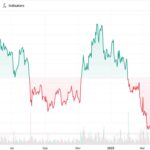The U.S. employment landscape demonstrated robust growth in March, as indicated by the latest report from the Bureau of Labor Statistics. Nonfarm payrolls surged by 228,000 jobs, significantly outperforming economists’ expectations of a 135,000 increase. Despite this positive job creation, the unemployment rate ticked up to 4.2%, slightly above the anticipated 4.1% as well as February’s figure.
In the wake of this employment news, the cryptocurrency market showed some intriguing developments. The price of Bitcoin (BTC) remained stable around $82,600 just moments after the job report was released. Interestingly, as economic conditions fluctuate, market watchers noted a growing sentiment that could signal changes in Federal Reserve policy regarding interest rates. The CME FedWatch Tool indicated that traders are speculating on potential rate cuts, with a 60% probability for a reduction as soon as June.
The backdrop of these economic shifts has been tumultuous, triggered by recent tariff announcements by former President Trump. The immediate aftermath saw major stock indices, including the Nasdaq and S&P 500, experience sharp declines, with the Nasdaq dropping by 6% and S&P 500 by nearly 5% on Thursday.
Amidst the turmoil in traditional markets, investors are looking for safer places to park their assets. Gold, which historically serves as a safe haven, remains near its record highs despite slight losses following the tariffs. Furthermore, U.S. Treasury bonds attracted significant interest, causing the yield on the 10-year note to drop notably, reflecting the broader concern surrounding economic stability.
Interestingly, Bitcoin’s recent performance has sparked discussions about its role as a potential safe haven asset. Although it has mirrored declines in the tech-heavy Nasdaq in past weeks, it demonstrated resilience by holding above the $80,000 mark even as major equities faced pressure. This could signal a developing trend of decoupling between Bitcoin and traditional markets.
As attention turns to upcoming inflation data set to be released next week, the economic environment continues to evolve, leaving many to wonder how these dynamics will shape both conventional and cryptocurrency markets in the months ahead.

The U.S. Employment Situation and Market Reactions
The recent developments in the U.S. employment landscape and market reactions could significantly impact various sectors and individual financial strategies. Here are the key points to consider:
- Nonfarm Payrolls Increase
- March’s nonfarm payrolls rose by 228,000, exceeding expectations of 135,000.
- This suggests a robust job market, potentially influencing consumer spending and economic growth.
- Unemployment Rate
- The unemployment rate increased to 4.2%, slightly above the expected 4.1%.
- A rise in unemployment could signal potential economic strain, affecting consumer confidence and spending habits.
- Federal Reserve’s Interest Rate Outlook
- Market expectations indicate a 60% probability of a rate cut in June, following the jobs report.
- Changes in interest rates can directly impact borrowing costs, influencing mortgages, loans, and overall consumer credit.
- Market Volatility
- Markets reacted sharply to Trump’s tariff announcements, with the Nasdaq plunging 6%.
- Investors may need to reassess their portfolios in light of ongoing geopolitics and market volatility.
- Safe Haven Assets
- Gold and U.S. Treasury bonds are seeing demand as safe havens amidst market tumult.
- Investing in safe havens may protect against potential losses in equity markets.
- Bitcoin’s Stability
- Bitcoin has shown signs of stability, maintaining levels around $82,000 even amidst market declines.
- An increasing interest in Bitcoin could suggest a shift in how individuals view and use cryptocurrencies in volatile markets.
- Upcoming Inflation Data
- March inflation data is expected to reveal ongoing price pressures, with estimates around 3% for both core and headline CPI.
- Inflation trends will be crucial for consumers and policymakers as they impact interest rates and purchasing power.
Understanding these developments can help readers make informed decisions regarding investments, spending, and saving in this evolving economic climate.
Analyzing the March Employment Report: Opportunities and Challenges Ahead
The latest employment figures from the U.S. paint a robust picture of the job market, indicating a significant addition of 228,000 nonfarm jobs. This is a positive development compared to the previously expected 135,000 and suggests that the economy is resilient, even amidst volatile market conditions such as those triggered by recent tariff announcements. However, an uptick in the unemployment rate to 4.2% raises questions about labor market dynamics, signifying potential challenges for policymakers.
Competitive Advantages: The job growth reported is an encouraging sign for economic health, providing a foundation for sustained consumer spending. For businesses looking to expand or invest, this employment growth presents a favorable climate. However, as the Federal Reserve contemplates interest rate adjustments, the relationship between employment figures and monetary policy might lead to a tightening of financial conditions aimed at preventing overheating in the economy.
Competitive Disadvantages: The increase in the unemployment rate, although slight, contrasts initially positive payroll growth, which could dampen consumer confidence. Additionally, the tumult in the stock markets, particularly the Nasdaq’s steep decline in response to tariff policies, adds uncertainty that could affect employment momentum. Economists and investors alike must grapple with the implications of potential rate cuts—and their timing—as they navigate this precarious economic landscape.
The implications of these developments could be significant for various market players. On one hand, sectors relying on consumer spending may benefit from a stronger job market, while those exposed to international trade could face challenges from rising tariffs and retaliatory measures, further complicating their outlook. Investors focusing on safe-haven assets, such as gold and U.S. Treasuries, may find reassurance in the current climate, while those betting on stocks may need to adopt a cautious strategy as market sentiment fluctuates.
As the market prepares for the upcoming March inflation data, stakeholders will be keenly analyzing whether the current job growth can maintain its momentum amidst external pressures, such as trade policies and potential Fed interventions.

















